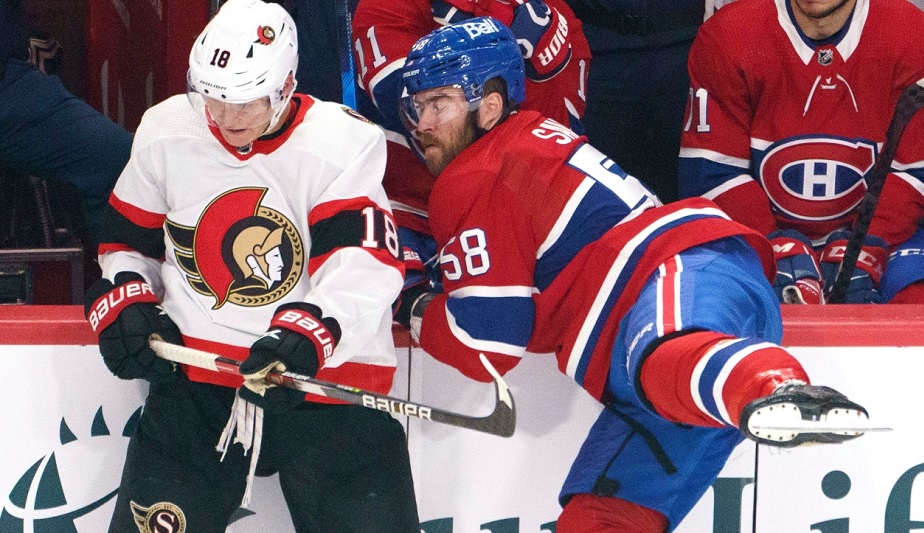There’s a Groundhog Day quality to the way roster problems on some NHL hockey teams seem to linger on, year after year.
Take the Montreal Canadiens — a decade-long deficit at centre is finally more or less in the past and longtime depth weaknesses on left defence and both wings have slowly but surely been turned into strengths for the present and future through a series of trades, free agent signings and focused drafting.
So it’s not as if general manager Marc Bergevin has been sleeping at his desk. So why the half-hearted efforts to fix the glaring hole on right defence?
Being a contender in the modern NHL means running out three competent defence pairings, preferably each with both left-handed and right-handed shooters, mostly because seeing someone attempting to clear the defensive zone up the boards on the backhand these days is something elite NHL players really look forward to.
Anyone who watched last summer’s playoffs probably noticed less-than-inspiring work from Jon Merrill and Erik Gustafsson in limited minutes as they spelled the big four of Shea Weber, Jeff Petry, Joel Edmundson, and Ben Chiarot as a clear team weakness. An overworked Habs blueline with only four skaters fully trusted by the coaching staff was arguably the biggest reason Tampa Bay was able to win the Stanley Cup Final so handily.
There’s even some irony involved when comparing the teams’ trade deadline pickups – while Montreal was settling for journeymen lefties like Merrill and Gustafsson, Tampa Bay went out and got a right-shooting frontline defenceman in David Savard to shore up the right side of its third pairing.
But a new contract for Savard was too rich for the cap-strapped Lightning, so Bergevin was able to sign the Quebec native as a free agent replacement for Weber on the right side of the second pairing, as Weber is expected to be out for at least this entire season as he recovers from a series of serious injuries.
With the Habs tight against the cap, Bergevin’s attempts to fill out his third pairing for the 2021-22 season became by necessity a thrift operation. The prospect pool on defence is considerably deeper in left-handers than right-handers, but few were far enough along to compete for an NHL position this year. When training camp opened, the main candidates to play on the right side of the third pairing were three low-cost options — free agent signing Chris Wideman — last season’s defenceman of the year in the KHL — free agent signing Sami Niku and Swedish prospect Mattias Norlinder.
With left-shooting Niku and Norlinder injured in camp, Wideman and his right shot won the job mostly by default rather than scintillating play. And while a couple of weeks worth of games is a small sample size, this smallish puck-mover who struggles in his own end has yet to look like anything more than press box filler.
Compounding this depth problem is the worrisome development of young left-handed defenceman Alexander Romanov, still feeling his way along as a second-year player in the league. Not trusted enough for a regular shift during last summer’s Stanley Cup run, third-pairing minutes this season with a steady and solid partner would be ideal for his development, but with the team’s slow start, Romanov has seen a variety of partners and has been moved up and down the lineup over the first few games of the season.
What Bergevin needs to do before the season runs away from him is to just fix his offseason mistake. He needs to acquire a reliable right-handed defenceman in a trade, either to mentor Romanov or to allow Savard to mentor Romanov. That would come in third-pairing sheltered minutes, where the young Russian can find his NHL game without his confidence taking any more of a beating than it already has.
It’s time for Bergevin to get bold and start sifting through NHL rosters for the right player. The Canadiens have no shortage of quality assets that can be spared to pick up a game-changing piece to the puzzle. Even being up against the cap is a relatively minor problem; a quick glance at the Habs and Rocket rosters reveals as many as 14 wingers who can play in the NHL right now, with eight or nine of them even capable of holding down top-six roles. Moving a winger from the NHL roster in a trade for the defence asset itself, or as a separate transaction to keep the team cap-compliant, will give the Canadiens three solid defensive pairs that will no longer have to be endlessly obsessed over.
And there shouldn’t be too great a problem finding candidates to make offers to.
Alphabetically, the first team on the list is the Anaheim Ducks. The Ducks have a right-handed defenceman in Josh Manson, a UFA at season’s end, who might be available before long, depending on how Anaheim’s season starts and what adjustments they feel need to be made to their roster to find success.
Bottom line, the defence as it’s constructed right now is a clear weakness, even with the return of Edmundson from injury and his current leave of absence. It can’t go on like this too much longer if the Canadiens hope to return to the playoffs.
